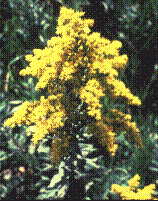Canada Goldenrod (Solidago canadensis)

One of the most widespread native plants in North Dakota, Canada goldenrod occurs throughout much of North America, at elevations under 9,000 ft. Plants exhibit a bewildering array of varieties, including 5 in the Great Plains.
Plants are perennial from single or multiple stems and normally are about 3 ft. tall. A simple caudex (enlarged stem base) or creeping rhizomes can be present. Plants are hairy above the middle. Leaf texture and hairiness and flower head size are the highly variable characters. Plants with longer flower heads and leaves nearly smooth on the upper surface are most common in our area. Leaves are usually about 2 to 4 inches long, toothed, and distributed quite uniformly up the stem. The yellow flower heads are about 1/4 inch long and consist of about 8 disc flowers surrounded by 15 ray flowers. Fruits are tiny achenes equipped with white bristles to aid transport by wind. Look for Canada goldenrod in September in rich soils of native grassland. More plants seem to occur where grazing is light or moderate, perhaps because of the slightly better soil moisture conditions than are found under heavy grazing. Amerindians used the achenes (seeds) of Canada goldenrod for food, especially in emergencies. The plant produces an oil that was once commercially extracted, but I was unable to determine what use was made of the oil.
Goldenrods are members of the sunflower family (Asteraceae). Aster means "star" in Greek, in reference to the radiate arrangement of the flowers in the heads. The family contains over 15,000 species, more than any other family in North Dakota as well as nearly every country in the North Temperate Zone. The generic name stems from the Latin solidus, "whole," probably in allusion to the reported properties of the goldenrods to heal wounds. There are about 100 species of goldenrods in North America; most are found in the East.
![]()
![]()
Back to Plants
 Wildflower
Seed For Sale
Wildflower
Seed For Sale